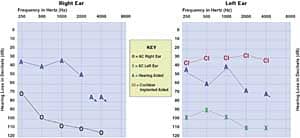Research shows that people make buying decisions based on emotions and feelings. Then they justify their purchase (and its cost) based on facts or information learned about the product or service.
What can a hearing care professional learn from this important insight into consumer behavior? That the most cutting-edge technology and advanced features mean little to patients considering a hearing aid purchase—unless they are translated into emotional benefits that individuals relate to and have a strong desire to attain. When you communicate specific benefits based on each patient’s individual feelings and needs, you can help them begin to see your recommendation as a quality of life “investment”—not as a cost they must reluctantly endure as the result of a disability.
Assessing Emotional Needs and Developing Trust
With hearing aid purchases, patients are dealing with a physical loss that literally affects them each and every day. Whether they are willing to admit it or not, many patients are motivated to consider hearing aids out of fear and a sense of growing isolation or missed opportunity in their lives. In other words, they have sought out your services based on an emotional need.
Unfortunately, these emotions are often very negative, and can include frustration, anger, and sadness. Your patients may be experiencing social isolation because they have trouble hearing during conversations with friends. Daily tasks, such as shopping and driving, may have begun to make them feel uncomfortable. Or they may be experiencing sadness because they are no longer able to hear and understand their children and grandchildren on the telephone. In short, they may feel isolated from the family and society they loved and cherished.
Getting patients to share their emotional needs with you takes trust, and trust is built through open and honest communication. Be sure to spend between 50% and 75% of your time with patients asking open-ended questions and receiving answers about their lifestyles, their buying motivations, and their level of knowledge about hearing aid technology and how it works. Engage in active listening in order to really understand your patients’ concerns.
Use the initial consultation as an opportunity to have dialogue with patients so that they feel connected and confident that you are invested in their well-being and only interested in making appropriate recommendations. You can’t build trust without understanding. And you can’t get patients to share with you the real and unique challenges they may be facing because of hearing loss without developing trust.
Providing the “Right” Information
Tapping into the emotional benefit of the hearing aid purchase does not mean you never communicate the value or features of the technology that you are recommending. Remember, people justify their purchases with facts and information they have learned over time about the product or service. If the patient does not have enough information or lacks a clear understanding about how the recommended device will improve their hearing health or quality of life, their unanswered questions will create active doubt. In time, active doubt manifests itself in the form of an objection. And for many patients that objection is cost.
Doubts and fears are natural and typical in a situation where the cost is significant, the technology is unknown to the patient, and where the outcome affects their sense of well-being. That is why it is so important to provide the value proposition that patients need to support their buying decision. While it is important to share information about product-specific features, be careful not to use an overwhelming amount of technical jargon that may cause the patient to feel confused or ignorant.
Gear your discussion of the product’s technology around the understanding that you have of the patient’s emotional needs. For example, “Mrs Smith, the hearing aid that I’m recommending automatically adjusts during telephone conversations. So hearing your granddaughter speak to you on the phone shouldn’t be a problem any longer.” This tactic helps to establish and support your bond with patients by showing that you heard and understood their emotional needs.
Addressing Patient Concerns
Even when you communicate the emotional benefits of your recommendation, patients may still cite cost as the reason they don’t want to move forward with the purchase. But is cost really the reason—or just the excuse? The vast majority of patients seeking hearing aids are age 50 or older. These individuals are a part of the most affluent age segment in our country. So, when mature patients express cost concerns, the questions are: 1) Are they truly unable to afford your hearing aid recommendation? 2) Or are they being thrifty? 3) Or is there something else on which they are basing their purchasing decision?
It has been proven that the mature consumer demographic has no problem purchasing quality products—as long as they are able to understand the value that the product adds to their lifestyle. It has also been proven that today’s consumer is more likely to make a significant purchase decision based on the monthly payment amount rather than the total cost. This may be because the average American has only about $300 available credit on their consumer credit cards, and can’t comfortably write a check for more than $500 out of their monthly budget. Even if they have the money available, many people would prefer to pay a smaller, monthly payment and reserve their savings “just in case.” And that is definitely the case for many mature patients.
If cost is truly a concern for patients, integrating a financing solution into the presentation and discussion of recommendations and fees is a very effective way to address and overcome the barrier to acceptance. Present the treatment or hearing aid technology cost as a monthly payment, in addition to the total fee. For example, “Mrs Smith, the hearing instrument that I’m recommending will cost you about $56 a month, or $2,500 total.” Using this technique will not only address patient concerns but will go a long way in reinforcing your commitment to ensuring that patients get the appropriate hearing aids.
With digital technology averaging $2,300 per instrument, purchasing hearing aids is an investment that many patients reluctantly make. By engaging your patients and uncovering their true emotional needs, then presenting your recommendation while communicating the benefits, your patients will begin to see you and hearing aids in a whole new light.
Correspondence can be addressed to [email protected] or Paul Findly at .






